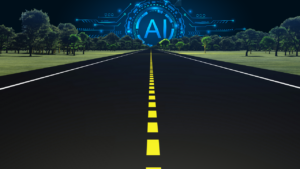Several years ago, Ron Craig, a Senior Principal Product Marketing Director at Oracle, wrote, “The ability of enterprises to generate data is increasingly outpacing their ability to realize real value from that data. As a result, opportunities for innovation, driven by customer, market and competitive intelligence are being left on the table. And given that only a subset of the avalanche of data is being put to good use, it’s entirely possible that the use of inadequate data is leading to bad decisions. A key source of this problem is that the productivity of human beings simply hasn’t kept pace with the technologies we have developed to help improve our business processes.”[1] Craig predicts that organizations that transform into autonomous enterprises will find future success. At Enterra Solutions®, we help our clients on their journey to becoming Autonomous Intelligent Enterprises.
What is an Autonomous Intelligent Enterprise?
Analysts from BMC note, “Conventional wisdom says that companies must adapt or die. To manage escalating change, as well as supply-and-demand chain upheaval, heightened customer expectations, and security and compliance pressure, companies across industries are reinventing themselves around a focus on digital and analytics. Now more than ever, a ‘business as usual’ mindset can lead to irrelevance.”[2] For years, business consultants have insisted companies need to transform into digital enterprises to remain relevant. More recently they have gone further to insist that businesses need to move towards greater autonomy in their business processes; hence, a new emphasis on autonomous intelligent enterprises. Tech journalist George Lawton calls it an automation revolution.[3] He explains:
“Enterprises are in the early phases of a revolution whose mission is to make more kinds of business systems, equipment and processes perform with less human intervention. This autonomous revolution is rapidly moving from one-off experiments to a collective effort to build digital fabrics that can keep up with the rapid pace of change in supply chains, geopolitics and the environment. The promise? An increase in efficiency, scalability and profitability on a level previously unknown.”
There is no universally accepted definition of what constitutes an autonomous intelligent enterprise. BMC analysts define it this way: “It’s a digital-first business with distinct tech tenets and operating model characteristics that support transformation through actionable insights, business agility, and customer centricity.” Analysts from Extreme insist an autonomic intelligent enterprise embraces three characteristics.[4] According to them, an autonomous intelligent enterprise:
• Is Self-Driven. “An autonomous enterprise is a network that automatically and intelligently self-drives and self-optimizes, enabling organizations to deliver new and improved experiences to everyone it touches.”
• Is Self-Optimizing. “It’s a network that can automatically detect and correct errors. A network that baselines user and device behaviors and implements policy controls when it sees a deviation. A network that understands what the business-critical applications and experiences are, and automatically optimizes around them.”
• Operates with Complete Freedom. “It’s far more than just artificial intelligence, machine learning, and gold-standard security: it’s freedom. Freedom to connect with customers, employees, students and patients in new and meaningful ways while the network runs itself.”
There are two threads that weave their way through all discussions of autonomous intelligent enterprises: data and cognitive technologies. Autonomous intelligent enterprises leverage both data and analytics to optimize their business processes. According to Phil Fersht, CEO and Chief Analyst at HFS Research, companies that aren’t already transforming into autonomous intelligent enterprises might be forced in that direction this coming year. He explains, “Nothing dictates real secular change to enterprise operations [more] than financial pressures, and we are rapidly arriving at a third major trigger that will lead to the evolution of many autonomous enterprises where leaders have no choice but to drag their operations out of the dark ages.”[5] That “trigger,” according to Fersht will be a convergence of “wage inflation, recession, and people refusing to return to the office.” This trigger “will drive a considerable wave of autonomous enterprises [relying] on technology to perform the tasks of humans to stay afloat.”
Towards the Autonomous Digital Enterprise
I’m not as pessimistic as Fersht regarding the reasons organizations will transform into autonomous digital enterprises. In many cases, technology will be used to augment, rather than replace, humans in the workplace. Businesses now operate at computer speed. Technologies, like artificial intelligence, are necessary to ensure organizations can maintain that speed. Analysts from Kalypso note that disruptions to business operations can be caused by many things, like political turmoil, cyberattacks, natural disasters, and environmental challenges. They add, “The convergence of these social, political, and economic factors underscores the increasing risks affiliated with over-reliance on human presence and human decision-making for business-critical operations.”[6]
To help clients cope with a rapidly changing business environment during the pandemic, we developed the Enterra Global Insights and Decision Superiority System™ (EGIDS™) that leverages Autonomous Decision Science™ (ADS®). ADS is the next step in the journey beyond data science. Using ADS, the machine plays the role of the data scientist or subject matter expert to help optimize an enterprise’s operations and decision-making so that it can run at the speed of the marketplace. As a result, organizations can make decisions that take advantage of market opportunities as quickly as possible. According to Vanja Josifovski, Founder and CEO at Kumo, and his colleague Ivaylo Bahtchevanov, “Today, when enterprises say they are ‘data-driven,’ they primarily rely on a backward-facing approach for making decisions. The role of data and analytics teams is to aggregate historical data to pull out insights and then use those learnings as a proxy for understanding the future. Having a human interpret the data is necessary to form an opinion on the state of the future. This human-in-the-loop approach is very expensive and error-prone, further exacerbated by the cost of reactive decision-making.”[7]
As you might imagine, you can’t simply wave a magic wand and become an autonomous intelligent enterprise overnight. According to Shailesh Manjrekar, Chief Marketing Officer at CloudFabrix, there are four levels enterprises go through on the path to digital autonomy.[8] They are:
Level 1. Discovery: “Level one is really a descriptive phase where you are taking a stock of all your IT assets, application assets and business assets. It’s about taking inventory.”
Level 2. Predictive autonomy: “[Level two is] where you do what-if analysis as you observe those assets, looking at trends and predicting anomalies.” Josifovski and Bahtchevanov, note, “A better approach for making decisions would be to build a set of models to predict all relevant future outcomes based on possible actions and determine the best decision.”
Level 3. Prescriptive autonomy: “The third level of autonomy is prescriptive, where after your what-if analysis, you can decide what action you’re going to take.” Levels two and three are the levels at which the Enterra Global Insights and Decision Superiority System primarily works. It is capable of running hundreds of simulations, offering prescriptive insights to help decision makers select the best decision possible.
Level 4. Cognitive autonomy: “All of this intelligence becomes part of your information systems.” This is the level at which Autonomous Decision Science is fully implemented.
Concluding Thoughts
Although the concept of an autonomous intelligent enterprise has been around for a few years, author Joe McKendrick notes, “Artificial intelligence can pave the way to autonomous operations, but requires an intelligent data supply chain behind it.”[9] With the right data and the right technologies, autonomous intelligent enterprises are now a distinct possibility. Analysts at Tangentia explain, “With the rapid maturation of increasingly sophisticated technologies, enterprises now have an opportunity to bring new levels of context, intelligence, and automation to day-to-day processes and decision-making in a way that spans organizational silos and enables holistic, enterprise-wide change. In short, they can work toward becoming an autonomous enterprise.”[10]
Footnotes
[1] Ron Craig, “Enabling the Autonomous Enterprise,” Oracle Blog, 19 August 2019.
[2] Staff, “The Autonomous Digital Enterprise Executive Brief,” BMC, June 2022.
[3] George Lawton, “The push is on to build the autonomous enterprise,” TechTarget, 10 June 2022.
[4] Staff, “Autonomous Enterprise,” Extreme, 2022.
[5] Phil Fersht, “2023 is the year of ‘The Autonomous Enterprise’ as economics trigger change,” Horses for Sources, 15 December 2022.
[6] Jordan Reynolds, Mithun Nagabhairava and Nick Ward, “The Autonomous Enterprise: Introduction,” Kalypso Viewpoints, May 2022.
[7] Vanja Josifovski and Ivaylo Bahtchevanov, “Kumo.AI: Bridging the Gap to the Autonomous Enterprise,” Kumo, 12 February 2022.
[8] Joe McKendrick, “The autonomous enterprise is near, but there are still some missing pieces,” ZDNet, 9 May 2022.
[9] Ibid.
[10] Staff, “The Future is Autonomous: Evolve and Stay Competitive,” Tangentia, 2022.





